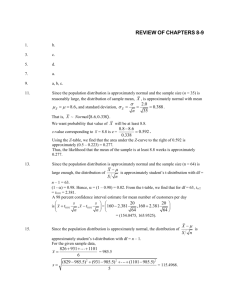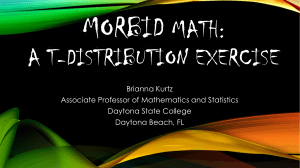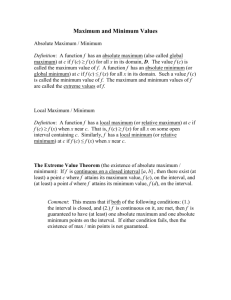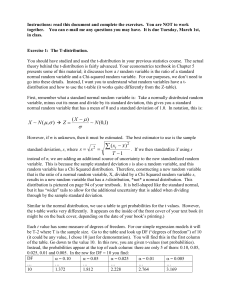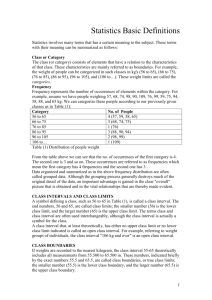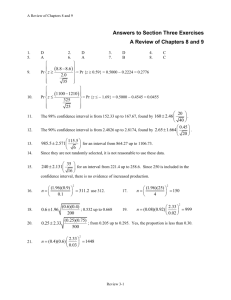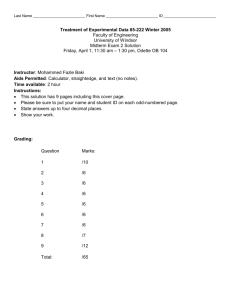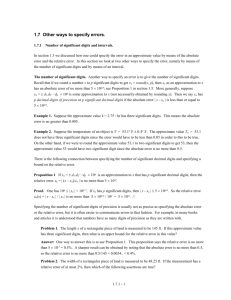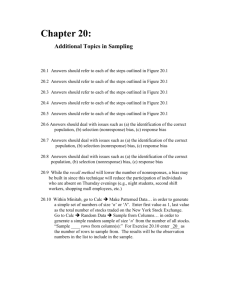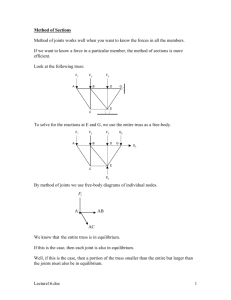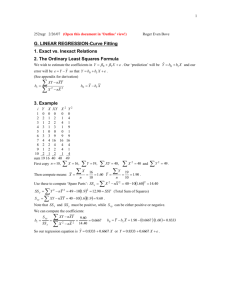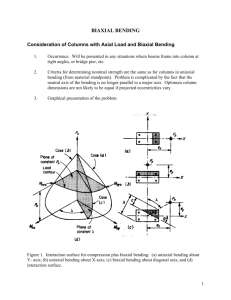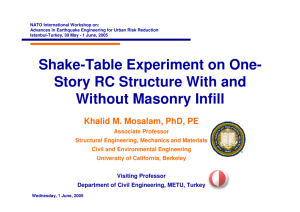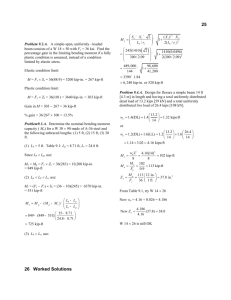Confidence interval estimations
advertisement
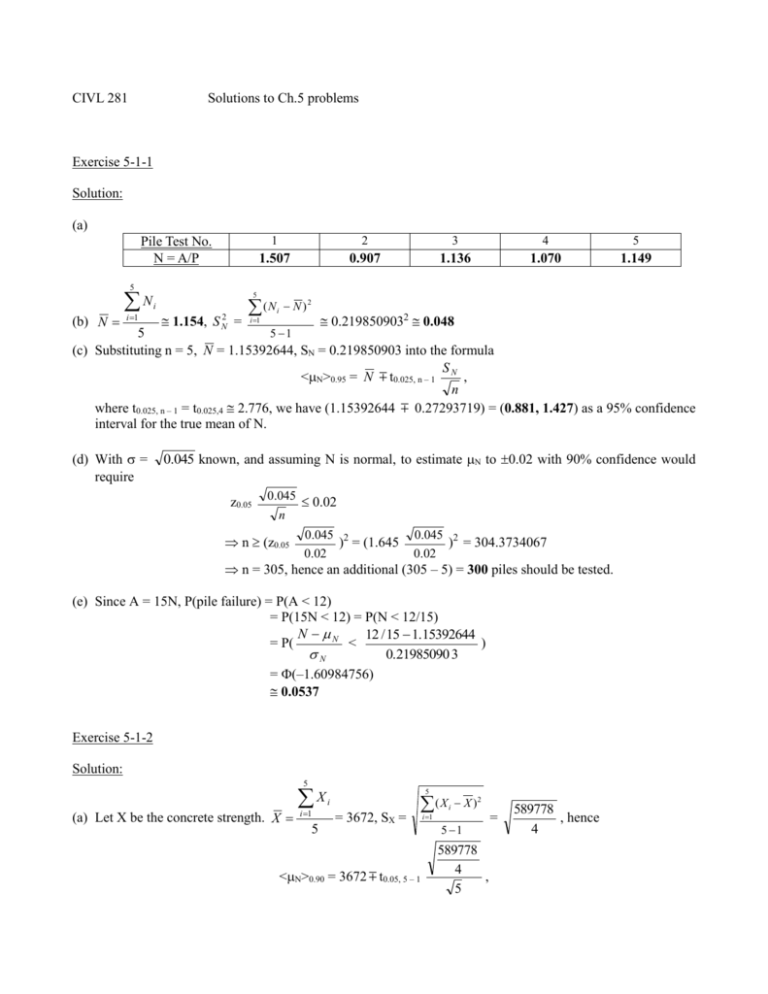
CIVL 281 Solutions to Ch.5 problems Exercise 5-1-1 Solution: (a) Pile Test No. N = A/P 5 (b) N N i 1 1 2 3 4 5 1.507 0.907 1.136 1.070 1.149 5 i 1.154, S N2 = (N i N )2 0.2198509032 0.048 i 1 5 5 1 (c) Substituting n = 5, N = 1.15392644, SN = 0.219850903 into the formula S <N>0.95 = N t0.025, n – 1 N , n where t0.025, n – 1 = t0.025,4 2.776, we have (1.15392644 0.27293719) = (0.881, 1.427) as a 95% confidence interval for the true mean of N. (d) With = require 0.045 known, and assuming N is normal, to estimate N to 0.02 with 90% confidence would z0.05 0.045 0.02 n n (z0.05 0.045 2 ) = (1.645 0.02 0.045 2 ) = 304.3734067 0.02 n = 305, hence an additional (305 – 5) = 300 piles should be tested. (e) Since A = 15N, P(pile failure) = P(A < 12) = P(15N < 12) = P(N < 12/15) N N 12 / 15 1.15392644 = P( < ) 0.21985090 3 N = (–1.60984756) 0.0537 Exercise 5-1-2 Solution: 5 (a) Let X be the concrete strength. X X i 1 5 5 i = 3672, SX = ( X <N>0.90 = 3672 t0.05, 5 – 1 i X )2 i 1 5 1 589778 4 , 5 = 589778 , hence 4 where t0.05,4 2.131846486, we have (3672 366.0877648) = (3305.91, 4038.09) as a 90% confidence interval for the true mean of N. Note: our convention is that the subscript p in t p, dof always indicates the tail area to the right of tp, dof (b) If the “half-width” of the confidence interval, t/2, 4 589778 4 is only 300 (psi) wide, it implies 5 589778 4 t/2, 4 = 300 / ( ) = 1.746996, 5 We need to determine the corresponding . On the other hand, from t-distribution table we have (at 4 d.o.f.) t 0.1, 4 = 1.533, t 0.05, 4 = 2.132, (and t/2, 4 increases as /2 gets smaller in general) Hence we may use linear interpolation to get an approximate answer: over such a small “x” range (from t = 1.533 to t = 2.132), we treat “y” (i.e. /2) as decreasing linearly, with slope 0.05 0.1 m= = – 0.083472454 2.132 1.533 Hence, as t goes from 1.533 to 1.746996, /2 should decrease from 0.1 to /2 = 0.1 + m(1.746996 – 1.533) = 0.1 – 0.0834724540.213996232 = 0.082137209 = 20.082137209 = 0.164274419 Hence the confidence level is 1 – = 1 – 0.164274419 83.6% Text 5.7 (a) Let xi be the DO recorded on the i-th day. Using the formulas x xi i 1 x n n and s i 1 i x 2 , n 1 n where n = 10 is our sample size, we obtain the point estimates for the population mean and standard deviation: x = 2.03 (mg/L), and s 0.485 (mg/L) (b) We are dealing with a normal population with unknown, which calls for the use of a student-t distribution; thus a 95% confidence interval for is formed by s xt* , where n where t* denote the limits between which the t-distribution with (n - 1) degrees of freedom covers an area of 95%. From tables, t* = t0.975;9 = 2.262, hence, plugging in these numbers and the answers from (a), we get [1.68 mg/L, 2.38 mg/L] as our 95% confidence interval for (c) The 95% lower confidence limit for is obtained as s , x t 0.95;9 n where t0.95;9 =1.833 from tables. Using the answers from (a), we obtain 1.75 mg/L as a 95% lower confidence limit for the true mean DO concentration. Text 5.10 Assuming population normality, and since n = 9, x = 20 (kips), (a) A 90% confidence interval for is formed by the endpoints x z* , n where the standard normal curve covers an area of 0.9 from between z*. Tables (for Z) tell us that z* 1.645, hence, assuming = 3 (kips), the confidence limits are 3 . 20 1645 = [20 + 1.645, 20 - 1.645], i.e. 9 [18.36, 21.65] is a 90% confidence interval for the population mean strength (in kips). . (b) Let the required sample size be r. A 95% confidence interval would be formed by x 196 equating this to the numbers from part (a) 3 2165 . 4 20 + 1.96 r 2 . 3 r 196 21654 . 196 . r 1645 . 9 r ;



